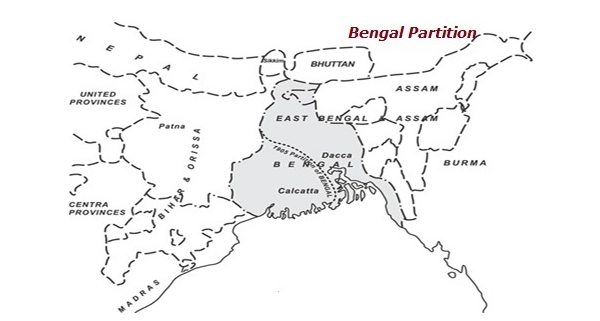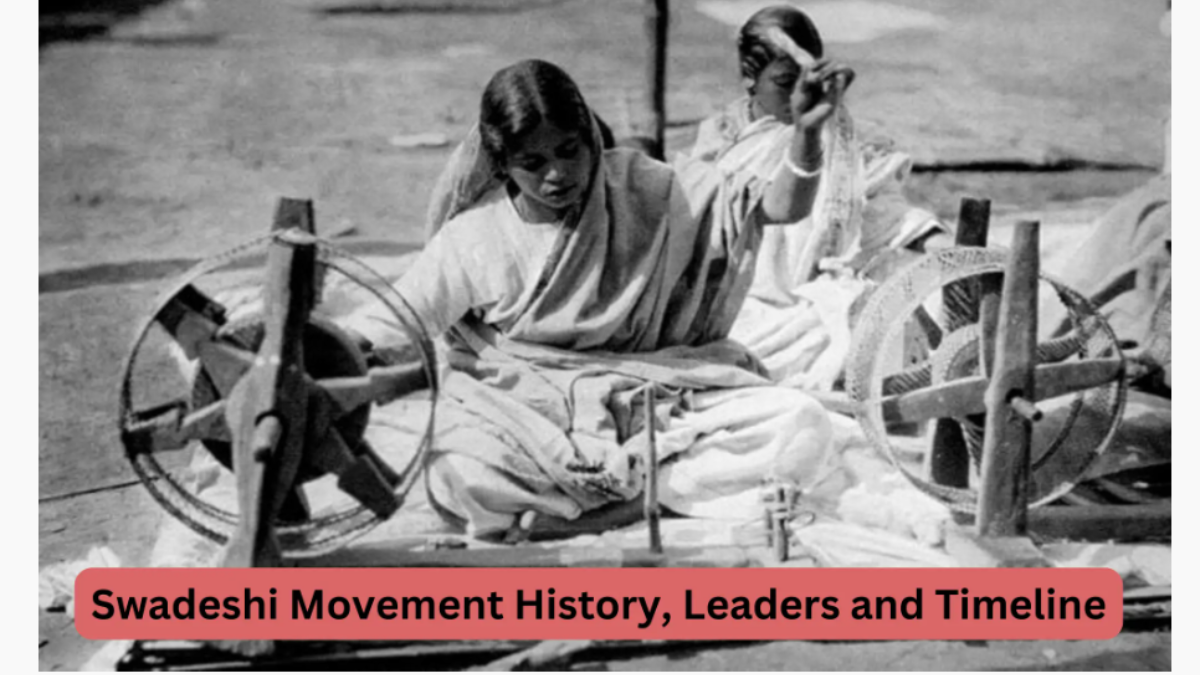Table of Contents
The Swadeshi and Boycott Movement began in Bengal and soon spread across India, gaining national importance. Bal Gangadhar Tilak played a crucial role in promoting this movement at the national level. He strongly advocated for transforming it into a nationwide freedom struggle against British rule.
Tilak believed that boycotting British goods and promoting indigenous products would weaken the British economy and boost India’s self-reliance, in the past the Drain Theory by Dadabhai Naroji had already bought out the loots made by the British from India. His efforts were supported by the moderate leader, Gandhi Ji called the Swadeshi movement as soul of Swaraj.
History of Swadeshi Movement
The Swadeshi Movement was a significant chapter in India’s struggle for independence from British rule. The movement was launched in 1905 in response to the British decision to partition Bengal, which was seen as a move to weaken the Indian nationalist movement. The Swadeshi Movement was an expression of India’s desire for economic self-reliance and cultural revival, and it played a vital role in shaping the country’s political and social consciousness.
Swadeshi Movement Reason
The Swadeshi Movement called for the boycott of British goods and the promotion of Indian-made products. The movement’s leaders urged Indians to boycott British cloth and other goods and to wear only Indian-made garments, to patronize Indian-owned businesses, and to use indigenous products. The movement gained widespread support from all sections of Indian society, from peasants and workers to intellectuals and political leaders.
Swadeshi Movement Leaders

Swadeshi Movement Timeline
- The Swadeshi Movement was identified with the production of cloth in India.
- It began in the mid-1800s and was championed by prominent Indian nationalists like Dadabhai Naoroji, Gopal Krishna Gokhale, Mahadev Govind Ranade, Bal Gangadhar Tilak, Ganesh Vyankatesh Joshi, and Bhaswat K. Nigoni.
- The movement aimed to promote Indian nationalism and was divided into three phases: the first phase, from 1850-1904, involved organizing and promoting indigenous products like hand-spun cloth ‘khaddar’ and vernacular education.
- The second phase, from 1905-1917, saw the movement oppose the partition of Bengal, which led to the growth of revolutionary groups and attempted arm revolts.
- The third phase, from 1918-1947, was led by Mahatma Gandhi who encouraged Indians to boycott foreign goods and promote indigenous products like Khadi.
- This phase saw the growth of Khadi spinning centers and the branding of Khadi spinners as freedom fighters.
- The movement had a significant impact on the British economy, with sales of British goods declining by 20%.
The movement also popularized the use and consumption of Indian products, with notable figures like Lal-Bal-Pal and V.O. Chidambaram Pillai promoting the use of indigenous products from soil to sweets and establishing Indian-owned shipping companies.
Swadeshi Movement Bengal Partition
In 1905, the British Raj made changes to the Bengal Presidency by dividing it into two parts during the first Partition of Bengal. The western areas were mostly inhabited by Hindus, while the eastern areas were predominantly Muslim. Lord Curzon, the Viceroy of India, announced the decision on July 20, and it came into effect on October 16. However, it was reversed six years later. Nationalists believed that the partition was a deliberate attempt to weaken Indian nationalism by dividing the province based on religious lines.

The Hindu population in West Bengal feared that the partition would make them a minority in the province, which would also include the states of Orissa and Bihar. They saw the partition as a “divide and rule” tactic, despite Curzon’s assertion that it would improve administration. The Muslim community, on the other hand, was motivated to create its own national organization based on their shared religion. The Swadeshi movement opposed the partition and caused riots, leading to Lord Hardinge’s decision to reunite Bengal in 1911 to appease Bengali sentiments.
Swadeshi Movement Legacy
Swadeshi Movement Impact
The Swadeshi movement was a significant event in the Indian independence struggle that started in 1905. It was a movement that aimed to promote Indian goods and industries, boycott foreign goods, and resist British colonialism. The movement emerged in response to the partition of Bengal by Lord Curzon, which was perceived as a deliberate attempt to divide and weaken Indian nationalism.
Swadeshi Movement Impact on Indian Art and Literature
The Swadeshi Movement exerted a profound influence on Indian art and literature by advocating the use of indigenous materials and techniques. Under its guidance, numerous writers and artists drew inspiration from India’s cultural richness. This period catalyzed the rise of a new cohort of Indian creatives dedicated to crafting an authentic and uniquely Indian aesthetic.
The Swadeshi Movement had a profound impact on India’s struggle for independence. The movement’s call for economic self-reliance and cultural revival struck a chord with millions of Indians who had grown disillusioned with British rule. The movement inspired a wave of nationalism that helped to galvanize the Indian nationalist movement and paved the way for the country’s eventual independence in 1947.
Swadeshi Movement’s Impact on Nationalism
The Swadeshi movement quickly gained momentum, with people from all walks of life joining in to support the cause. It marked the beginning of a new era of nationalism and revolution in India. The movement had a significant impact on the Indian independence movement, shaping the way Indians viewed British colonialism and inspiring them to take action.
One of the significant outcomes of the Swadeshi movement was the emergence of a new breed of leaders who were committed to the cause of Indian independence. The movement saw the rise of leaders like Bal Gangadhar Tilak, Lala Lajpat Rai, Bipin Chandra Pal, and others who were instrumental in shaping the future of the Indian independence movement. These leaders, who were fiercely nationalistic and committed to the cause of Swaraj, played a critical role in uniting Indians and mobilizing them against British colonialism.
Swadeshi Movement Impact on Indian Economy
- The Swadeshi movement also had a profound impact on the Indian economy. The boycott of foreign goods and the promotion of Indian industries led to the growth of the Indian economy.
- The movement inspired Indians to take pride in their own products and to patronize Indian goods.
- The promotion of Khadi, a hand-spun and hand-woven fabric, became a symbol of the Swadeshi movement and the Indian independence struggle.
- The movement also led to the establishment of several indigenous industries and the growth of Indian entrepreneurship.
- The Swadeshi movement had a significant cultural impact on India as well. The movement sought to revive and promote Indian culture, art, and literature.
- It inspired Indians to take pride in their own culture and heritage, and to resist the influence of Western culture.
- The movement also played a vital role in the growth of Indian languages, with Hindi and other regional languages gaining prominence.
- Finally, the Swadeshi movement had a lasting impact on the Indian independence struggle.
- It inspired several other movements, including the Non-Cooperation movement, the Quit India movement, and others that eventually led to India’s independence in 1947.
- The movement taught Indians the power of collective action, and the importance of unity and perseverance in the face of adversity.
The Swadeshi movement was a pivotal event in the Indian independence struggle that had far-reaching effects on Indian society, culture, and economy. The movement inspired Indians to take pride in their own heritage and to resist colonialism. It created a new generation of leaders who were committed to the cause of Indian independence, and it led to the growth of Indian entrepreneurship and industry. The movement continues to inspire Indians to this day, and its impact will be felt for generations to come.
| Related Articles | |
| List of Committees and Commissions in India before Independence | |
| Anti Defection Law Schedule, Meaning, Amendment |
|



 TSPSC Group 1 Question Paper 2024, Downl...
TSPSC Group 1 Question Paper 2024, Downl...
 TSPSC Group 1 Answer key 2024 Out, Downl...
TSPSC Group 1 Answer key 2024 Out, Downl...
 UPSC Prelims 2024 Question Paper, Downlo...
UPSC Prelims 2024 Question Paper, Downlo...





